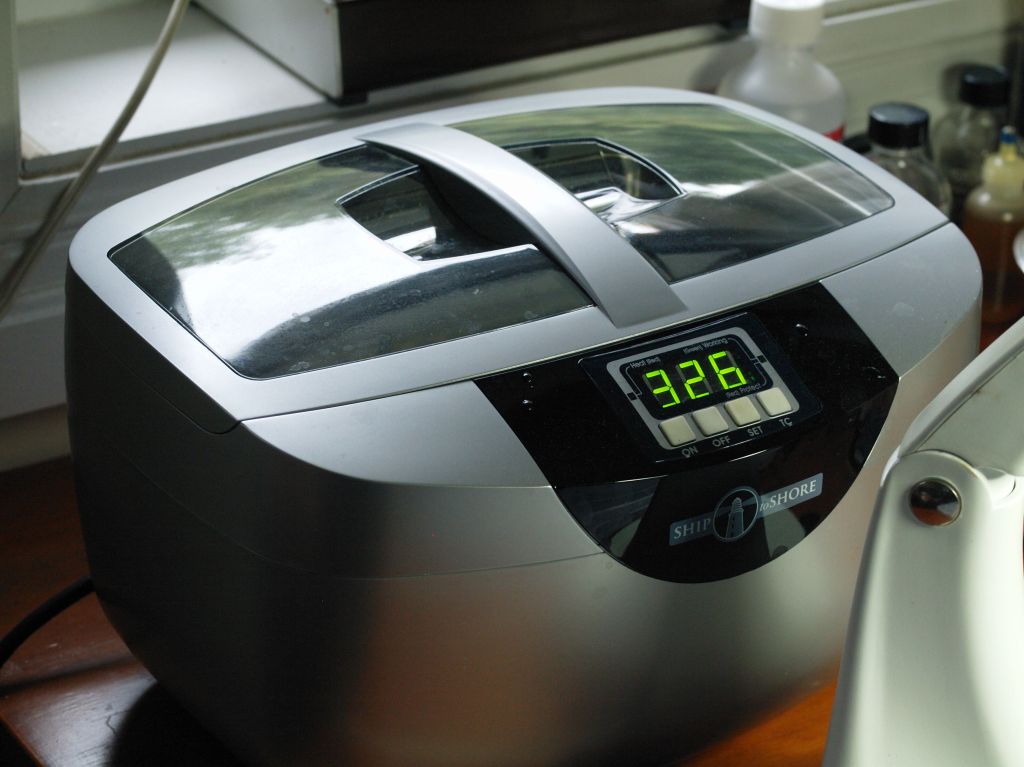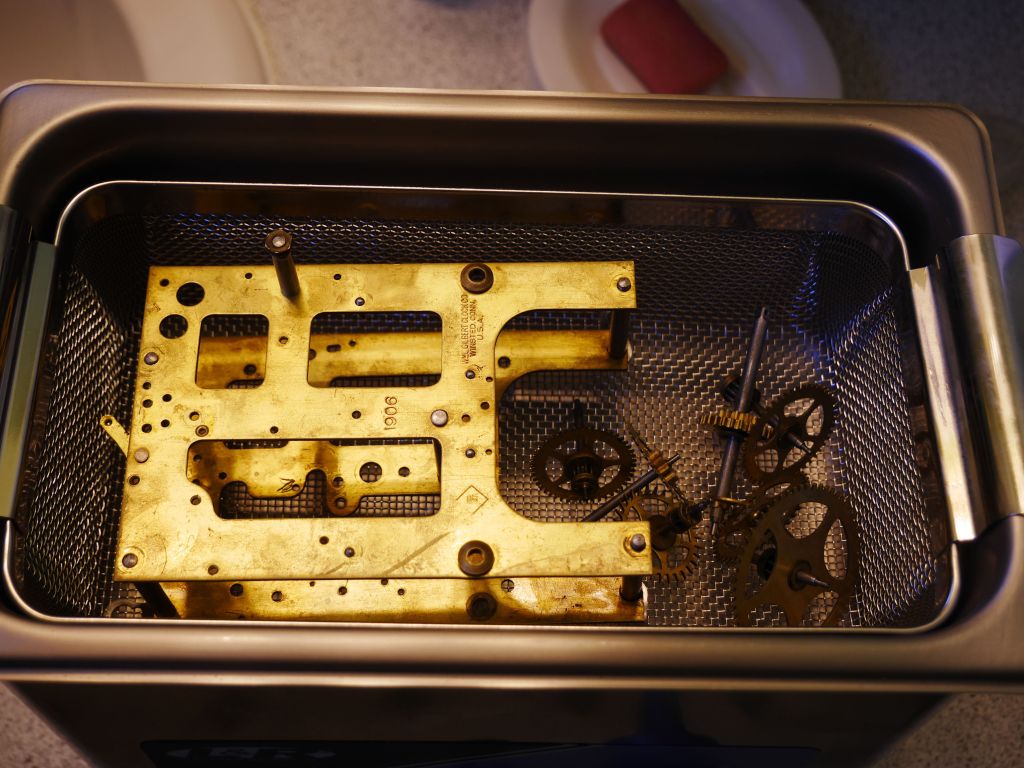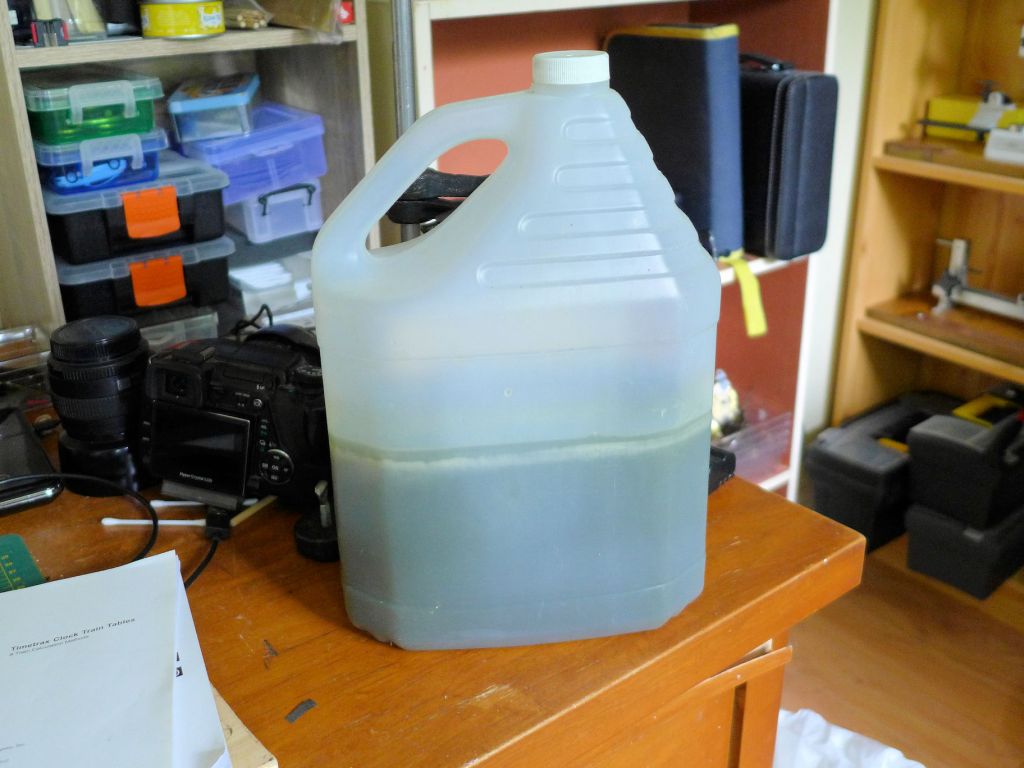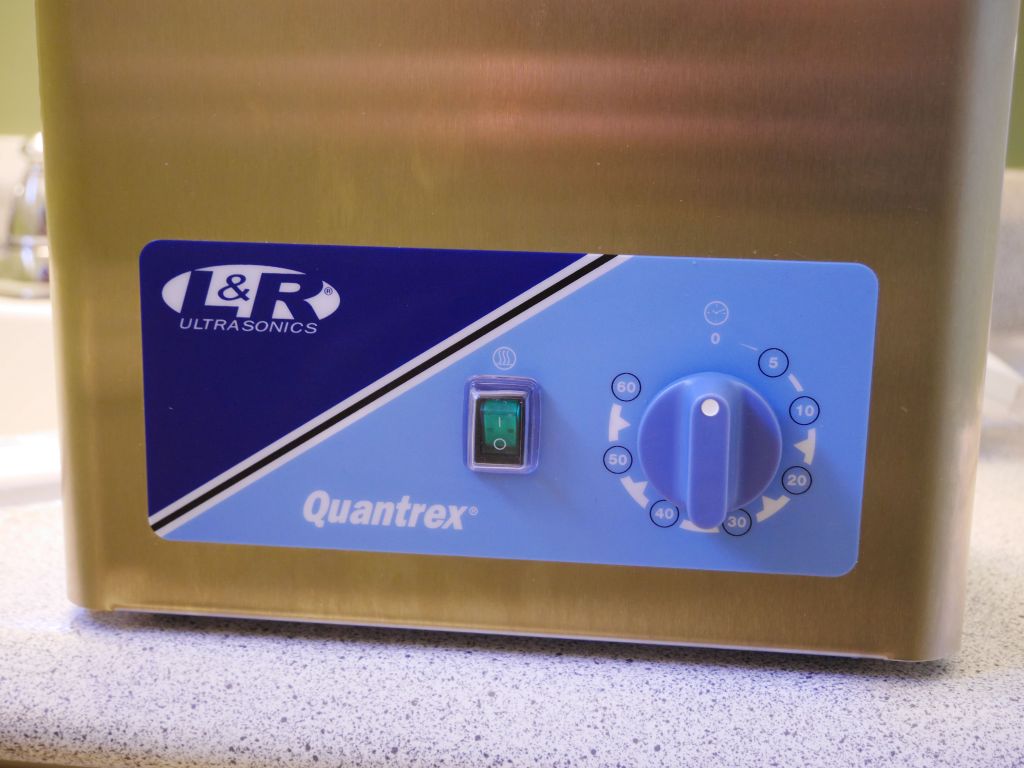Let’s dispense with something from the start. I am not a “Dunkin Swish” guy. Some of you might have heard of this term in your clock journey and if you haven’t it is good to know and to avoid at all costs.
“Dunkin Swish” (apologies to those named Duncan) involves placing an assembled movement into some sort of cleaning solution and/or an ultrasonic cleaning machine, drying it off and calling it cleaned. This is the absolute worst method of cleaning a clock movement and never a good way to clean mainsprings within their spring barrels. Why? Only by taking things apart can you inspect parts, polish pivots, peg holes and generally get rid of dirt and grime in the small crevices of a movement that will accelerate wear.
There is only one method to properly clean a clock movement, complete disassembly and that includes removing mainsprings from their barrels.
The following is a set of steps I always take for cleaning clock parts.

In the majority of cases clock parts can be safely cleaned by an ultrasonic cleaning machine but in rare cases when working with something very old and delicate, hand cleaning may be the only option.
Therefore, in this article I will proceed with the assumption that most clocks you would be working on are common variety mechanical movement types from anywhere in the world.
Let’s begin
Pre-cleaning
Once I have movement apart I clean any stubborn stains or wipe off excess oil on the parts beforehand. From experience I know that while an ultrasonic cleaner does a wonderful job it is not magic and difficult stains do not readily come off in the cleaner.
Pre-cleaning serves another purpose, it makes the cleaning solution last longer. The solution can be used safely several times and when it reaches the point where I can’t see through it or there is too much dirt in suspension I dispose of it.
I also peg out all the pivot holes beforehand and clean oil from the pivots. I even wipe excess oil and dirt on the mainsprings.
The ultrasonic cleaner
In the early of clock repair days I relied on a cheap ultrasonic cleaning machine. It was satisfactory for small jewellery items but not for clock parts.

I was on the search for a better ultrasonic cleaner and found many Chinese ones on Amazon and eBay. I suppose some have had excellent experiences with Chinese-made ultrasonic cleaners and certainly the prices are attractive but I was looking for something of decent quality and a good warranty. I have nothing against Chinese ultrasonic machines and would only rely on them if they had a good return policy and warranty.
I chose L&R for two reasons, their reputation and warranty. I receive nothing from this company but the link will allow you to research their products for a size that fits your needs. After 3 years of continuous use my L&R cleaning machine has been flawless. L&R meets all of my needs.

The Q140 will hold one complete movement but is a bit of a tight fit for larger movements. Its smaller size means less cleaning solution is used and quicker heat-up times.
A good quality ultrasonic cleaner will not let you down. There are probably other brands that are just as good if not better but you get what you pay for.
Using an ultrasonic cleaner
Ultrasonic cleaners use cavitation, created by ultrasonic waves, to scrub objects made of nonabsorbent materials. Look how bright and shiny this 30-hour movement is after an ultrasonic cleaning.

Should everything go into the ultrasonic? I avoid putting anything plastic and mixing metals aside from steel and brass. Some modern clock movements that have plastic/nylon gears/parts should be cleaned separately and not go into an ultrasonic cleaner.
Make your own judgment on some friction fit parts such as a centre gear and pinion as there is risk of damaging them if you are not confident they can go back together easily. Otherwise take apart as much of the movement as you can.
The cleaning solution
Avoid anything flammable such alcohol, gasoline, or other flammable liquids. They will vaporize, and could cause a fire or explosion, or release harmful gasses into the workspace. And breathing these are never good.
Only solutions that are specifically designed for an ultrasonic cleaner should be used.
There are other acceptable cleaners but I have used Polychem Deox 007 as a cleaning solution for a number of years and it works very effectively. Deox-007 an environmentally friendly, non-ammoniated concentrate cleaner. It is mildly alkaline for the efficient removal of oils, grease, tarnish, stains, corrosion and oxidation from brass, bronze, copper, gold and silver. And once it has outlived its usefulness it can be safely dumped down the drain.
Avoid mixing metals beyond brass and steel in the cleaner as they may react with each other unless there are separate compartments for each type in the ultrasonic. Of course, you would need a larger machine to separate items when cleaned in one sitting.
The Deox 007 mix is 5 to 1 ratio with water. It is also odour-free.

On many cleaners there is a safe fill line which is approximately 1 inch from the top of the tank. No matter if you are just cleaning one part or several, always bring the solution to the fill line.
A stainless steel wire basket is also necessary. Do not place parts directly on the bottom of the cleaning tank.

Although I always drain the solution after each use, I understand why some repairers leave it in the tank if the ultrasonic cleaner is used daily.
No cleaning method I know of is as effective in cleaning lantern pinions as an ultrasonic cleaner. The results are nothing short of amazing.
The ultrasonic session
I generally pre-heat the solution which involves pouring in the solution, turning on the heater and allowing the ultrasonic to come up to temperature and that takes about 10 minutes.

I run the ultrasonic for 20-30 minutes and that seems to be enough for most jobs. On rare occasions I have run parts through twice.
Next is drying all the parts and this is where speed is essential. It is surprising how quickly rust forms on the steel parts. I use shop towels and for difficult locations such as lantern pinions I use a hair dryer. Occasionally, if my wife is baking I will put the parts in the oven during its cool down phase. Years ago some repairers harvested the parts from discarded hot-air popcorn machines but I don’t see any of those around anymore. Also, in the past some repairers designed heat boxes using a light bulb but today’s LED bulbs run far too cool.

If you have elected to place mainsprings in the ultrasonic is is important that they be dried as quickly as possible.
I suppose one could clean in phases, time side first then the strike side if drying is a concern. To each his/her own.
Once everything is dry the next phase in any repairs, bushing or pivot work and then reassembly and testing.
So that’s my method. Let me know if you have a technique or method that is different than mine or if you have included additional steps.

Dear Mr. Joiner, I read you columns on clock repair with interest. The latest one on clock cleaning was of particular interest. For drying the parts after cleaning (I too use an L&R ultrasound), I built myself a dryer. It’s a cube, roughly 18 x 18 x18 inches a side. In the bottom are cut a few slots to permit egress of air. I bought a bonnet hair dryer (see Amazon) took off the bonnet and cut a hole the top of the cube the same diameter as the diameter of the tube that leads from the heating unit. I made some legs. for the box. I have a fine mesh grill on which to place the parts while in the box. It works quite well. I’ll send photos next week. Regards, Mike.
Sent from my iPhone
>
LikeLike
Yes, it pays to buy a quality US. I am anxious to see your design. I have often thought of a drying box and an inexpensive hair dryer would certainly work. The mesh sounds interesting. Again, looking forward to the photos.
LikeLike
Thanks for sharing your knowledge and experience. As I novice follower, it’s an easy read instead of searching various clock forums.
LikeLiked by 1 person
Thank you.
LikeLike
Ron, Another great article you shared your knowledge. Funny thing. Hot Air Popcorn machines where also used by some home based coffee bean roasters. Of course, it produced a very small batch and control was “by gee-by golly”. Suppose too, some folks actually used them for popcorn. Another clock repairer also suggested a hair dryer in a wooden box for a drier.
LikeLike
Thanks Marty. Yes I have heard of the hair dryer box idea. Wouldn’t take much, hair dryers are cheap enough on Amazon.
LikeLike